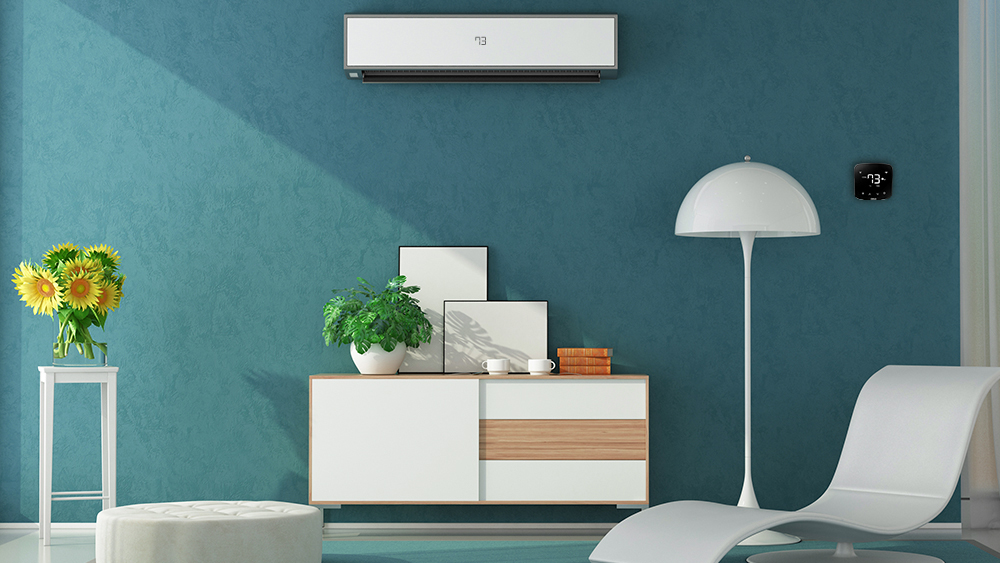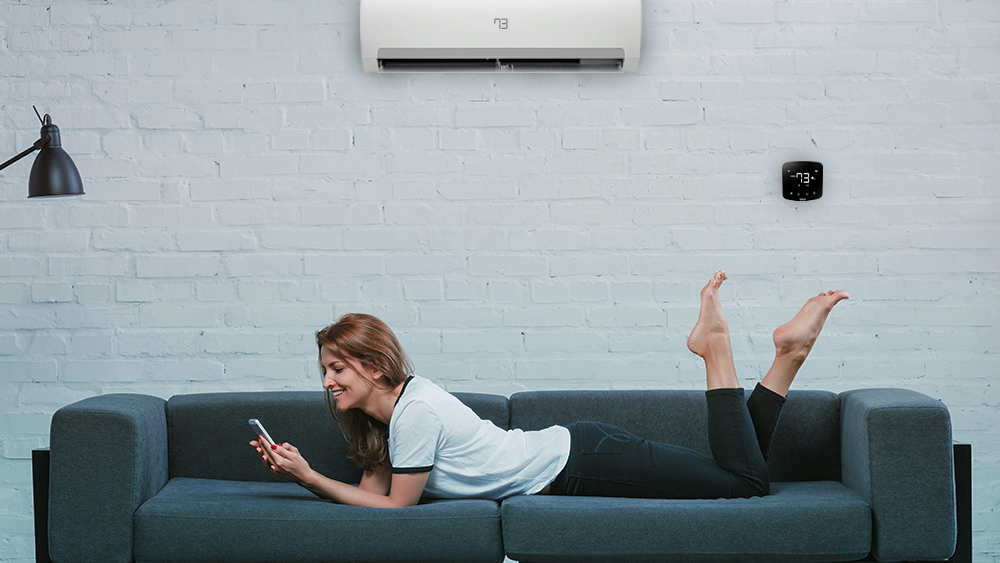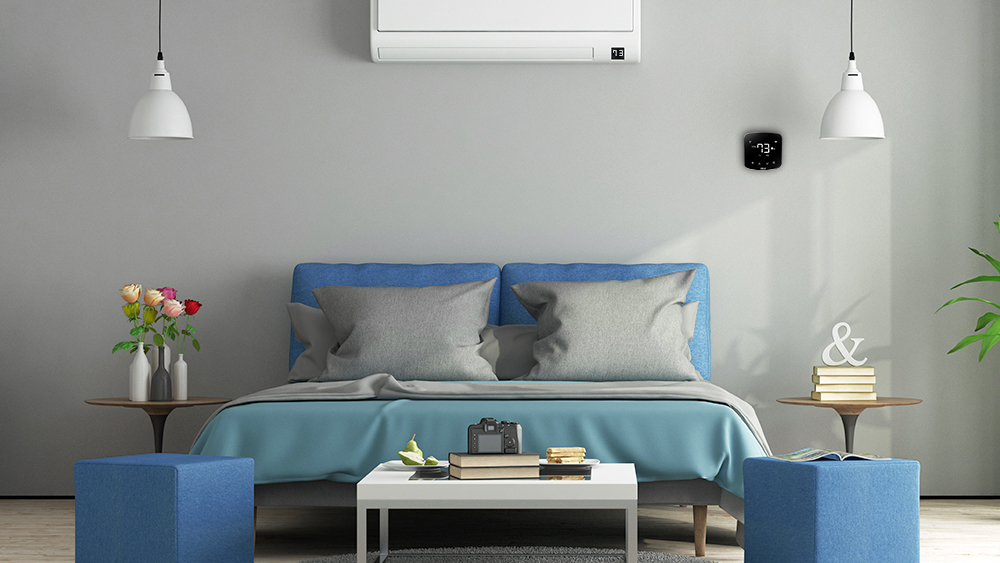
Key Takeaways
- Ductless systems provide both heating and cooling and can be used year-round.
- These systems are easy to install and don’t require lengthy ductwork.
- Ductless systems eliminate energy losses associated with ductwork, leading to reduced energy consumption.
Central HVAC systems have long been the standard for home heating and cooling, but ductless systems are rapidly gaining popularity. Homeowners are increasingly turning to these versatile systems, either as a primary solution for the entire house or as a supplementary option alongside their central HVAC. Ductless systems offer a highly adaptable and efficient way to maintain comfortable temperatures, making them an appealing choice for modern homes.
Whether you are adding a separate space in your home or upgrading your existing HVAC unit, you should be exploring the numerous advantages that ductless heating and cooling systems have to offer.
Plus, you can make them smart and control your home climate from anywhere in the world.
This blog will help you explore in detail the benefits of ductless air conditioning systems and see what the hype is about!
What are Ductless Cooling and Heating Systems?

Ductless heating and cooling systems, commonly referred to as mini-splits, are innovative HVAC solutions that provide temperature control without the need for traditional ductwork. Unlike central air systems, which distribute air through a network of ducts, ductless systems consist of an outdoor compressor unit and one or more indoor air-handling units connected by refrigerant lines.
The most common type of ductless AC unit is the wall-mounted mini-split. These systems feature an indoor unit mounted high on the wall, with the outdoor unit positioned directly outside, either on the ground or mounted on the exterior wall. Standard mini-splits can also be upgraded with a smart mini-split thermostat, allowing for enhanced control and energy efficiency. While there are other ductless options, such as wall-mounted multi-splits, packaged terminal air conditioners (PTACs), portable AC units, window units, and cassette-type air conditioners, this article will focus on the most popular choice: wall-mounted mini-splits.
Advantages of Ductless Cooling and Heating Systems
There are many benefits of ductless heating and cooling units over ducted systems. Let’s get started on understanding the benefits that ductless HVAC units provide:
1. Less Operating Expenses
This is the bottom line for most of us. We all love appliances that reduce our monthly energy expenses, and why not?
Ductless air conditioning systems are much cheaper to operate than ducted air conditioners. The biggest reason is the absence of ductwork.
Ducts present the most significant source of air leakage within ducted systems. Tears, gaps, improper installation, ruptures, etc., all contribute to the conditioned air leaking out and becoming wasted energy. The US Department of Energy estimates that homes with central air conditioning use up to 30% more power only due to leaking ducts.
Related: Forced Air vs. Central Air Systems: How Are They Different?
2. Make Your Cooling and Heating Smart!

Ductless heating and cooling units can be effortlessly upgraded to smart systems with plug-and-play smart mini-split thermostats like the Cielo Breez Plus and Cielo Breez Max. These devices enable you to control your air conditioning from the convenience of your smartphone, transforming your AC into a WiFi-compatible system.
With these smart climate control devices, you can manage your ductless AC from anywhere, at any time, enjoying all the features of a smart air conditioner—and more—at just a fraction of the cost.
In addition to remote control, these smart thermostats offer advanced features such as temperature and humidity-based triggers, location-based automation, weekly scheduling, usage history tracking, and seamless integration with smart home systems like Google Home and Amazon Alexa.
Your best choice to make any mini-split, window,
or portable AC smart. Enhance your comfort and savings.

3. Ductless ACs Have Greater Efficiency
SEER and EER are ratings that you might have often heard about when searching for an air conditioning system. These ratings correspond directly to the amount of energy that your air conditioner can save. Therefore, a higher SEER means that the air conditioner is more energy-efficient.
Ductless air conditioning systems, on average, have a higher SEER rating than their ducted counterparts, with some systems having a SEER as high as 30.
4. Hassle-Free Installation
The lack of ductwork in ductless air conditioners allows for significantly quicker and easier installation compared to traditional ducted systems. This streamlined process not only reduces the time required for installation but also dramatically lowers installation costs.
This makes ductless air conditioners an excellent choice, especially in homes without pre-installed ductwork. If your home already has ducts installed, the cost can be significantly lower. Mini-split systems can be up to 50% less expensive.
For even greater savings, a DIY ductless AC installation is also an option.
The only modification to your home will be a small, inconspicuous 3″ x 3″ hole behind the indoor unit, which is completely hidden once the installation is complete. The entire process is quick, hassle-free, and minimally invasive.
5. Reduced Carbon Footprint With Ductless AC Units
As discussed before, ductless heating and cooling systems offer much greater SEER and EER. This higher efficiency translates directly into a lower carbon footprint than ducted systems. Moreover, ENERGY STAR certification means that they are highly energy-efficient units. Hence, you get reduced energy bills and reduced carbon emissions.
Another major contributor to these systems’ reduced carbon footprint is the use of certain AC refrigerants. For example, R410A is an environmentally friendly refrigerant that reduces the impact of air conditioning on the ozone layer.
Related: How Environmentally Clean Is Your HVAC System?
6. Improved Indoor Air Quality
The quality of the air we breathe plays a crucial role in our health and well-being, especially for those who spend a lot of time indoors. Poor indoor air quality, often compromised by airborne bacteria and viruses, can significantly impact our health.
Ducted air conditioning systems are particularly problematic in this regard, as their ductwork can harbor mold, algae, fungi, and even small pests. These indoor air contaminants can easily spread throughout the home, making it essential to prioritize clean indoor air for optimal comfort and health. Moreover, small insects and rodents can also be found in ducts, especially if they have holes in them or are very old.
On the contrary, ductless heating and cooling systems provide very comprehensive filtration options. Top-of-the-line HEPA filters can block out 99.97 percent of all airborne particles sized 0.3 microns or larger. Even the standard in-built air filter in a ductless air conditioning system can efficiently block out dust and allergens.
Related: Mini-Split vs Central Air Conditioner: Which Type Is Best Suitable for Your Home?
7. Greater Flexibility
Ductless ACs offer greater placement flexibility because they don’t rely on an extensive network of ducts to distribute air. Instead, they consist of compact indoor units that can be mounted on walls, ceilings, or even recessed into the ceiling, allowing them to fit seamlessly into various spaces. The only connection required is a small refrigerant line running to the outdoor unit, which can be installed up to 50 feet away. This flexibility makes it easier to place the units exactly where they’re needed, whether in individual rooms, open spaces, or areas that are difficult to cool with a traditional ducted system. This consumes far less energy and results in decreased AC bills.
8. HVAC Zoning
HVAC zoning for ductless systems refers to the ability to divide your home into distinct areas or “zones,” each with its own independently controlled temperature. In a ductless system, each zone is managed by its indoor unit, allowing you to customize the heating and cooling in each space according to your needs.
This zoned approach enhances energy efficiency by avoiding the need to heat or cool unused areas, provides personalized comfort throughout your home, and helps you put an end to thermostat wars at home.
You just require a smart thermostat for your mini-split to connect your ductless units and create a zone. All the units in each zone can be controlled with a single tap rather than tuning on/off them individually.
9. Minimal Maintenance
Ductless HVAC systems offer the benefit of minimal HVAC maintenance compared to traditional ducted systems. Since they lack ductwork, there are fewer components to clean and maintain. The primary maintenance tasks involve regularly cleaning or replacing the filters in the indoor units and ensuring the outdoor unit remains clear of debris.
Without the extensive ductwork that can accumulate dust, mold, and allergens, ductless systems not only reduce the frequency and complexity of maintenance but also help improve overall indoor air quality. This ease of upkeep contributes to their long-term efficiency and reliability, making them a convenient choice for maintaining a comfortable home environment.
However, it is advised that you schedule regular AC tune-ups before the start of the summer season and follow these simple steps to extend the life of your ductless AC.
Related: The Ultimate Spring HVAC Maintenance Checklist
10. Ductless Air Conditioners Also Provide Heating!
Yes, you heard that right. Some ductless systems provide cooling and heating without any additional modifications. These “reversible” units or ductless heat pumps can function both in summer and winter. This versatility makes ductless heating and cooling very attractive compared to most ducted systems that can only cool your home, leaving you needing a separate furnace to keep you comfortable in the winter.
11. Improved Health & Safety
Ductless HVAC units do not have the fire or gas poisoning risks associated with electric or gas space heaters. Similarly, you don’t have to worry about carbon monoxide poisoning like you would with gas heaters. You can now enjoy a warm and cozy night’s sleep without worrying that if you do it off, your house will catch on fire.
12. Variable Speed Compressors
These days, most ductless heating and cooling systems have variable-speed compressors, otherwise known as inverter-driven compressors. Variable-speed compressors work by using an inverter to adjust the speed of the compressor motor according to heating or cooling requirements.
Instead of all the power going to the compressor, the inverter provides a specific amount of voltage to the compressor. This leads to huge energy savings. Moreover, variable-speed compressors also have a longer lifespan compared to their fixed-speed counterparts.
It also adjusts refrigerant flow according to the system’s needs. So, for example, if you feel your room is too cool, adjust the thermostat accordingly. Rather than shutting off the entire system, the variable-speed compressor will precisely calibrate the refrigerant flow according to the cooling requirements. This reduces wear and tear, as the system doesn’t have to turn on or off repeatedly.
Related: Inverter Air Conditioner: A Comprehensive Buyer’s Guide
13. Quiet Operation
Ductless systems are considerably quiet; you will barely notice that an air conditioner runs in your room. This will help you stay comfortable without getting distracted by AC sound when working or sleeping.
14. Get Utility Rebates With Ductless Heating and Cooling
Due to the higher efficiencies of ductless heating and cooling systems, many utility companies now offer rebates and financial incentives to homeowners and businesses to install them. In addition, by upgrading to selected smart thermostats, you may qualify for rebates that further enhance your savings. For example, Cielo devices are eligible for various rebates, and pairing an eligible smart mini-split thermostat with your ductless system offers an additional opportunity to reduce your energy costs. These programs are designed to incentivize the adoption of energy-efficient technologies, benefiting both users and the environment.
Ductless Air Conditioners Are the Way to Go!

In summary, ductless HVAC systems offer unmatched flexibility and energy efficiency compared to traditional ducted air conditioners. Whether you’re outfitting a new home or renovating an existing one, ductless heating and cooling systems should be a top consideration. They provide numerous advantages, including flexibility in placement, convenience, personalized comfort, significant energy savings, smart capabilities, and a reduced carbon footprint. These benefits make ductless air conditioners a standout choice for modern climate control.









5 Comments. Leave new
Well this is awesome post and written very well.
It’s great to know that a ductless heating system can improve the air quality of your home to ensure healthy living. My husband and I plan on having a custom home constructed soon because we’re expecting our first child. I want the best for my family, so I’ll suggest we have a ductless heating system in our new home.
Your articles were very helpful.and a ductless heating system will work well in my old stone house. Thank you
Can you operate the cooling portion (compressor when it is below 65 degrees out) without damaging the compressor if it is both a heating and cooling unit?
Hi, running your AC in cool mode when the outside temperature is below 60F will freeze your AC coils and cause damage to the unit.